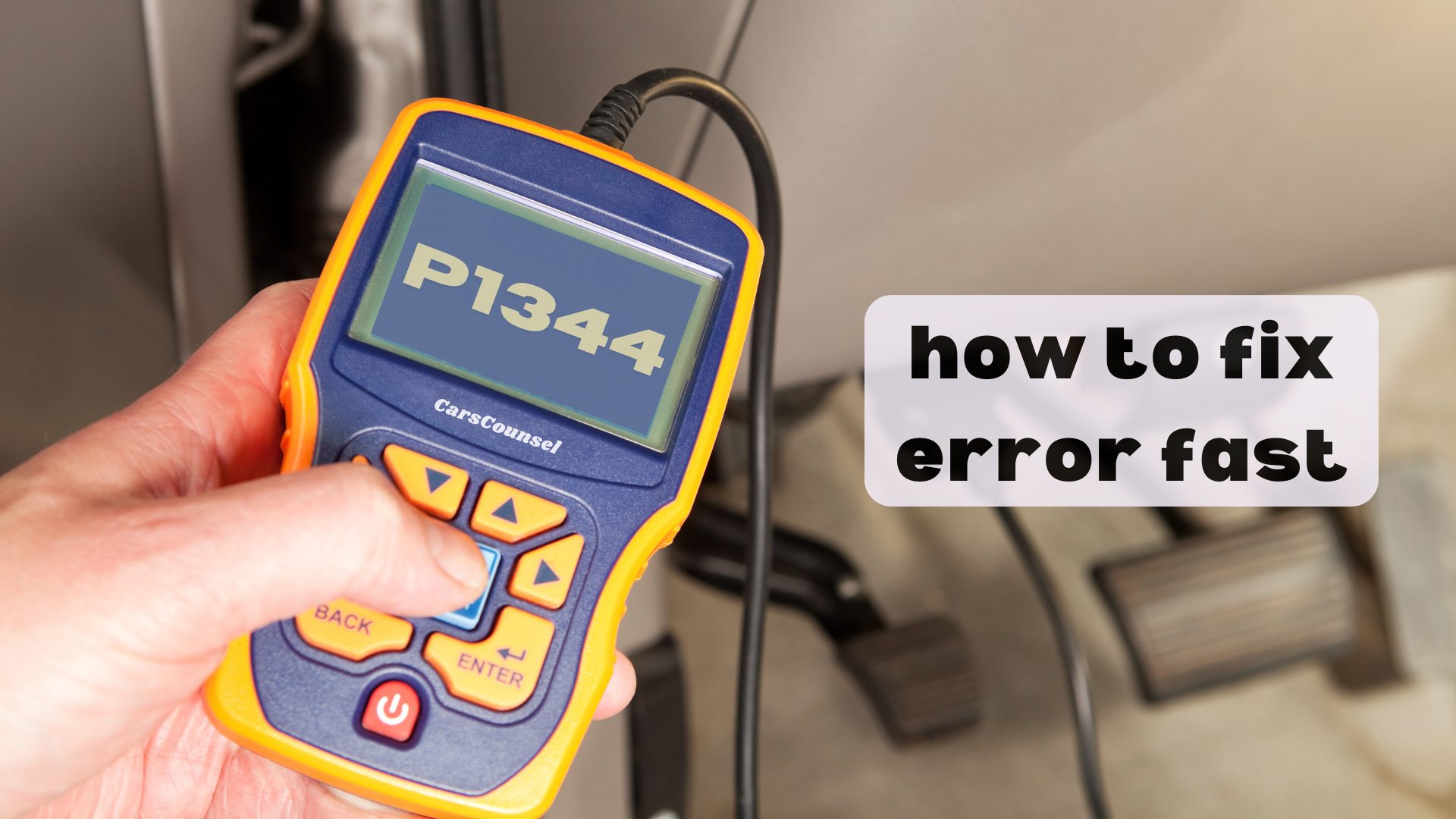You’ve noticed your engine struggling to start, and the check engine light has illuminated, displaying the P1344 code. You’re not alone, as many drivers have encountered this issue, characterized by misfires during start-up in cylinder 2.
This problem can stem from various causes, including faulty spark plugs, clogged fuel injectors, or ignition system issues. As you try to diagnose the root cause, you’re likely wondering what’s behind this misfire and how to get your engine running smoothly again. Let’s examine the possible culprits and solutions to get your vehicle back on track.

Quick Navigation
Key Takeaways
- A P1344 code indicates a misfire during start-up in cylinder 2, affecting engine performance, fuel efficiency, and emissions.
- Common causes of misfire include faulty spark plugs, ignition coils, fuel injectors, vacuum leaks, and low compression in cylinder 2.
- Symptoms of a P1344 code include rough starts, hesitation, rough idling, decreased acceleration, and engine stalling or shutting off.
- Diagnosing the misfire issue involves reviewing misfire data, checking fuel and ignition system components, and analyzing engine data.
- Repairing the P1344 code may require replacing faulty components, cleaning fuel injectors, and addressing vacuum leaks or internal engine problems.
Code P1344 Description
When your vehicle’s onboard diagnostic system logs a P1344 code, it’s indicating a misfire during start-up in cylinder 2 of the engine.
This error code means the engine is experiencing a problem with the combustion process in cylinder 2. Misfires can cause reduced engine performance, decreased fuel efficiency, increased emissions, and potential damage to other engine components.
Rough start or hesitation when starting the vehicle is a common symptom. Misfires can lead to a variety of issues if left unresolved.
A misfire during start-up in cylinder 2 affects the combustion process, which can impact engine performance. It’s essential to address this issue promptly to prevent further damage and maintain peak engine performance.
Common Causes of Misfire
Faulty spark plugs or ignition coils are often the culprits behind a P1344 code, as they can disrupt the spark that ignites the fuel-air mixture in cylinder 2.
You’ll also want to inspect your fuel injector, as a clogged or malfunctioning one can prevent proper fuel delivery to cylinder 2, leading to a misfire.
Issues with your ignition system, vacuum leaks in the intake system, low compression in cylinder 2, or valve problems in cylinder 2 can also cause a P1344 code.
It’s essential to identify the root cause of the misfire to guarantee proper repair. By understanding these common causes, you can take the first step in diagnosing and fixing the issue to confirm a successful fix.
Symptoms of P1344 Code
If your engine is misfiring during start-up in cylinder 2, you’ll likely notice some telltale signs.
Rough starts or hesitation when starting the vehicle are common symptoms of a P1344 code. You may also experience rough idling or vibrations while the engine is running.
Decreased acceleration and overall power are also indicative of a misfire issue. Moreover, engine stalling or shutting off unexpectedly can be a sign of a problem.
Additionally, you may notice decreased fuel efficiency, which can lead to increased fuel costs over time. In addition, poor engine performance and decreased fuel efficiency are just a few of the symptoms you may experience if your engine is misfiring during start-up in cylinder 2.
Diagnosing the Misfire Issue
To pinpoint the root cause of your P1344 code, you’ll need to diagnose the misfire issue in cylinder 2. This involves using scan tools to identify misfire patterns and analyze engine data. You’ll want to review the misfire data to determine when and how often the misfires occur. Does the misfire happen consistently or intermittently? Does it occur when the engine is cold or warm?
| Diagnostic Step | Description |
|---|---|
| Review Misfire Data | Analyze engine data to identify misfire patterns |
| Check Fuel System | Inspect fuel injectors, fuel pressure, and fuel volume |
| Inspect Ignition System | Check spark plugs, ignition coils, and spark plug wires |
Repairing the P1344 Code
With the diagnosis complete, you’re ready to tackle the repairs necessary to fix the P1344 code.
Since the misfire issue is isolated to cylinder 2, focus on replacing faulty spark plugs and ignition coils if they’re the root cause. Spark plug replacement is a straightforward process that can resolve the issue quickly.
Additionally, clogged fuel injectors may be restricting fuel delivery to cylinder 2, so perform a thorough fuel injector cleaning to guarantee proper flow.
Address any vacuum leaks in the intake system and internal engine problems, such as low compression or valve issues, as needed.
Cost to Fix P1344 Code
Your wallet may take a hit when fixing the P1344 code, as the repair cost can vary widely depending on the root cause of the misfire in cylinder 2.
On average, you can expect to pay between $150 and $500, including parts and labor, to fix the issue. Diagnostic time and labor rates can impact the final cost, so it’s essential to get a repair estimate from a trusted auto repair shop.
If you have insurance coverage, check your policy to see if it covers misfire repairs. Keep in mind that insurance coverage may vary, and you may need to pay out-of-pocket for some or all of the repairs.
Be sure to get a detailed breakdown of the repair estimates to understand what you’re paying for.
Preventing Future Misfires
After addressing the P1344 code, it’s vital to take proactive steps to prevent future misfires in cylinder 2.
You can’t afford to wait for another misfire to occur, as it can lead to further engine damage and decreased performance.
To prevent future misfires, prioritize regular maintenance, including regular spark plug replacements and fuel injector cleaning.
Additionally, verify proper fuel pressure and vacuum system integrity.
Implementing these preventive measures will help minimize the risk of misfires and keep your engine running smoothly.
Additional Resources
Several online resources are available to help you diagnose and repair the P1344 code, including YouTube tutorials, forums, and repair guides. These resources can provide valuable insights and step-by-step instructions to help you fix the misfire issue in cylinder 2.
| Resource | Description | Benefit |
|---|---|---|
| YouTube Tutorials | Visual guides for diagnosing and repairing P1344 | Easy to follow, hands-on instructions |
| Online Forums | Communities discussing P1344 code and repair experiences | Real-world examples, troubleshooting advice |
| Repair Guides | Detailed, step-by-step repair manuals for P1344 | Technical expertise, precise instructions |
More OBD-II Codes
Frequently Asked Questions
Can a Misfire in Cylinder 2 Cause Permanent Engine Damage?
If you’re experiencing a misfire in cylinder 2, you’re putting your engine under stress, which can lead to cylinder wear and potentially cause permanent damage if left unchecked, making prompt repairs vital to prevent long-term engine harm.
Will a P1344 Code Always Trigger the Check Engine Light?
You’ll likely see the check engine light if a misfire during start-up in cylinder 2 affects ignition timing or fuel injector performance, but it’s not a guarantee, as the light may not trigger immediately, depending on the severity of the issue.
Can I Drive My Vehicle With a P1344 Code Safely?
“When in doubt, throw it out” – in this case, your doubts about driving safely with a misfire. You can drive cautiously, but be aware of driving precautions and maintain safe distances, as misfires can lead to sudden stalls or loss of control.
Will a Tune-Up Fix a P1344 Code Without Further Diagnosis?
Will a tune-up fix the issue? Probably not, as spark plug wear or fouling might be the culprit, and a tune-up won’t address underlying problems like faulty ignition coils or fuel injector clogging, which require specific diagnosis and repair.
Can a Faulty Oxygen Sensor Cause a P1344 Code to Appear?
As you rev up your engine, a faulty oxygen sensor can be the hidden saboteur, tricking your engine into running rich, causing misfires, and ultimately, the P1344 code; but before replacing the sensor, consider fuel injector cleaning and spark plug checks to rule out other culprits.
Conclusion
You’ve addressed the P1344 code, and now your engine’s running smoothly again. But did you know that a misfiring engine can decrease fuel efficiency by up to 40%? That’s a significant dent in your wallet! By staying on top of regular maintenance and addressing issues promptly, you can avoid costly repairs and keep your engine purring like new. Remember, a well-maintained engine is a happy engine – and a happy wallet!

